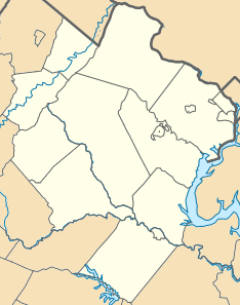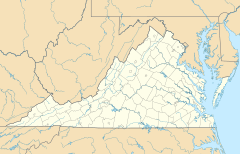Greenwich, Virginia facts for kids
Quick facts for kids
Greenwich
|
|
|---|---|
| Country | United States |
| State | Virginia |
| County | Prince William |
| Elevation | 360 ft (110 m) |
| Time zone | UTC−5 (Eastern (EST)) |
| • Summer (DST) | UTC−4 (EDT) |
| ZIP codes |
20181
|
Greenwich is a small community, also called a hamlet, located in Prince William County in the state of Virginia. It's a quiet place with a rich history, especially during the American Revolution and the Civil War.
Contents
Greenwich and American History
Greenwich played a small but interesting role in American history. It was a path for soldiers and a place where people tried to protect their homes during wartime.
The American Revolution: A March Through Greenwich
In January 1779, captured British and Hessian soldiers were marched through Greenwich. They were on their way to prisoner of war camps near Charlottesville, Virginia. Later, on June 5, 1781, General Anthony Wayne led his troops along the same route. His soldiers were going to help General Lafayette in the final battles of the Revolutionary War.
The Civil War: How Greenwich Stayed Safe
Greenwich was lucky during the Civil War. Even though many battles happened nearby, the community itself was not damaged. This was partly thanks to a clever man named Charles Green, who was from England.
Charles Green's Clever Plan
Charles Green owned a house called The Lawn, which was built in 1855. During the war, he flew the British flag over his home. This made it seem like his property was neutral, meaning it didn't belong to either side in the war.
Three years after building his home, Green gave land for the Greenwich Presbyterian Church. When Union soldiers wanted to use the church as a hospital, Green told them it was neutral British property. He said it could only be used as a church. The Union soldiers agreed and left the church untouched.
Soldiers Passing Through Greenwich
Both Union and Confederate armies passed through Greenwich many times between 1862 and 1863.
- On August 27, 1862, before the Second Battle of Manassas, Union divisions camped here. These included troops led by Generals Jesse Reno and Isaac Stevens.
- The next day, they marched to Manassas Junction. They were chasing Confederate General Thomas J. Stonewall Jackson's forces.
A Skirmish Near Greenwich
On May 30, 1863, Federal cavalry chased Major John S. Mosby's rangers through Greenwich. Mosby's rangers were a group of Confederate cavalry known for their surprise attacks. Mosby tried to fight back a couple of miles west of Greenwich. He used a small cannon, but he lost it and some of his rangers. One of them was Bradford Smith Hoskins, a former British officer. Hoskins was taken to The Lawn, where he died from his injuries. He was buried in the church cemetery.
Armies on the Move
On October 14, 1863, Confederate Generals A.P. Hill and Richard S. Ewell led their troops through Greenwich. They were chasing the Union army, which was moving back toward Washington's defenses. General Hill's attack on the Union army at Bristoe Station resulted in a tough defeat for the Confederates.
Greenwich Presbyterian Church: A Historic Landmark
The Greenwich Presbyterian Church and Cemetery was started around 1833. The land for the church was given by Charles Green, who owned the nearby estate called The Lawn. The church's cemetery has over 500 gravestones. It is the resting place for several soldiers from the American Civil War. This includes Captain Bradford Smith Hoskins, the British officer who rode with Colonel John S. Mosby.
Greenwich Today
Greenwich is mostly a residential area where people live. It has only two public places that are still open.
- Mayhugh's Grocery is a general store. It sells food items and has gas pumps for cars.
- The other public place is the Greenwich Presbyterian Church.
Both of these important places are located at the intersection of Vint Hill Road (which is VA Route 215) and Greenwich Road (which is VA Route 603).




